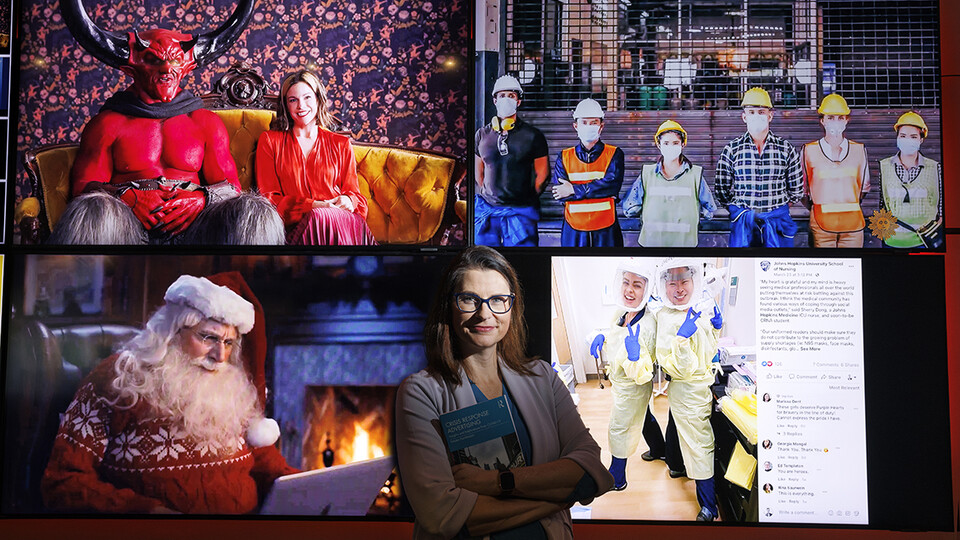· 6 min read
Hachtmann peeks behind the curtain at how COVID-era advertising evolved

Frauke Hachtmann’s deep dive into the advertising world’s response to COVID-19 is a guide for how advertising agencies and their clients can maneuver through a global crisis.
Hachtmann, professor of advertising at the University of Nebraska–Lincoln, talked to insiders about their pandemic workplace experiences, gaining insight into how they created messages for the time. Her peek behind the scenes aims to answer questions about how to respond to future crises.
“Behind the curtain is chaos, and we’re figuring out ‘What do we need, and what do we tell our clients?’” she said. “You had really, really big consumer brands calling their agencies saying, ‘We have no idea what to do.’”
In March 2020, as things began to shut down because of the pandemic, Hachtmann started recognizing trends among the new ads as agencies also had to shift their messaging.
“I noticed how the advertising around me just changed and a lot of the advertising sort of looked the same,” she said.
She reached out to some of the most successful agencies in the country and over the course of 15 months, interviewed 21 industry professionals from 18 top agencies in the country. She set out to learn more about how the agencies were advising their clients during an unusual time. As time passed and she spoke with more people, she heard many of the same things across the industry and used these stories to create a path for agencies to move through crises.
Hachtmann published her research this summer in her book “Crisis Response Advertising: Insights and Implications from COVID-19.” The book details the “Complex Crisis Response Advertising Model” she developed from her research, which takes into account the phase of the crisis, intervening conditions or variables and stage of the creative process. Hachtmann hopes the model serves as a foundation for future research and as an aid for advertising professionals.
Navigating how to respond became even more complex for clients when other things started to emerge, such as a related economic downturn, a mental health crisis and the growing Black Lives Matter movement.
Hachtmann divides advertisements from the emergence of COVID-19 onward into three phases. During the first, which Hachtmann calls “shock aborption,” most advertising opted for a message of unity. Brands would try to remain visible but rather than selling a product would focus on communicating empathy. Hachtmann said advertising followed a similar trend following the 9/11 attacks. However, consumers eventually develop “message fatigue.”
“It’s trying to create unity and providing some calm, and then people get tired of these messages,” Hachtmann said. “They wanted to escape.”
That leads to the next phase, which Hachtmann calls the “new temporary normal.” Ads would still acknowledge that something had changed, but they would also try to bring more humor and levity to the situation. Xfinity/Comcast cast actor Steve Carell as Santa communicating via video chat with his elves, in a lighthearted ad that highlighted people’s desire for togetherness during the holidays. Rather than promoting Black Friday prices, brands could make jokes while not ignoring the situation.
As the worst of a crisis winds down, brands enter the re-emergence/transformation phase. Going through the crisis becomes a catalyst for change. Hachtmann said this period offers brands an opportunity to take more risks and reevaluate their priorities. She found brands felt more responsibility to be socially aware and active.
“It’s an opportunity to reexamine what we stand for, what’s important to us,” she said. “It’s more about brand actions, like who or what are they supporting? What events are they creating? How are they selling?…Businesses have a lot of responsibility on their shoulders to do good in the communities that they serve and to benefit society.”
Hachtmann identified one Facebook campaign as an example of a company repositioning itself in the changed circumstances. Following public backlash against privacy policies, the company played a role in helping people connect during shutdowns. The ad featured a poem about enduring through hard times paired with photos and videos shared on the site.
Hachtmann’s research showed some best practices for different phases of a crisis according to the industry professionals. While still in the “shock absorption” phase, it’s not the time to go for a hard sell of a product. As COVID began to share headlines with other issues, Hachtmann found that in order to communicate about Black Lives Matter, for example, a brand should have already established a stance on the issue.
“If you don’t have anything to back that up through your actions, then you lose the trust of the consumer for other messaging too,” Hachtmann said.
In some circumstances, this could even include where they chose to place ads as the environment became increasingly polarized politically.
“People were kind of glued to the news but whether you advertised on Fox News or CNN told a different story,” Hachtmann said. “So as a brand, you have to think about, which one do I buy?”
In addition to the creative output, the interviews also taught Hachtmann about what was going on behind the scenes at these agencies. As some companies pulled advertising dollars, some agencies shifted to business consulting. They might have advised a car manufacturer who was temporarily producing protective equipment, a distillery producing hand sanitizer or a restaurant trying to set up curbside service.
“Their expertise areas evolved,” Hachtmann said. “The overall scope of the work for these advertising agencies had changed.”
They also had to navigate an industry that is highly collaborative when creatives couldn’t physically sit in a room together to solve communication problems. Hachtmann said when she was conducting interviews, agencies were still working through this transition. Although agencies used resources like Zoom to talk over ideas, professionals said they couldn’t recreate the environment of necessary creative friction online.
“We use that a lot in advertising, this healthy debate,” she said. “You need this or you’re going to produce really boring, run-of-the-mill work.”








